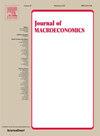What do we know about estimating government spending multipliers?
IF 1.5
3区 经济学
Q3 ECONOMICS
引用次数: 0
Abstract
Using the DSGE model as the data-generating process (DGP), we assess how three key modeling choices influence government spending multiplier estimates: (1) the econometric method—vector autoregressions (VARs) versus local projections (LPs); (2) the identification strategy for government spending shocks—such as recursive, Blanchard–Perotti (BP), or forecast error (FE) methods; and (3) the variable transformation—log versus Gordon–Krenn (GK). Our results demonstrate that even when using the same data set, these choices can lead to substantially different multiplier estimates. Furthermore, we find that the choice of econometric method should align with the shock identification strategy and targeted estimation horizon. For the short-run, LP method produces the most accurate government spending multipliers when the true shock sequence is known. When there is no strong candidate for the shock, BP-type shocks are preferable, with both VAR and LP methods being more suitable for short-run analysis, while VAR models yield more reliable estimates for long-run horizons. Additionally, using the GK transformation instead of the log transformation reduces the upward bias commonly observed in VAR and LP estimates.
关于估算政府支出乘数,我们知道些什么?
使用DSGE模型作为数据生成过程(DGP),我们评估了三种关键建模选择如何影响政府支出乘数估算:(1)计量经济学方法-向量自回归(var)与地方预测(lp);(2)政府支出冲击的识别策略,如递归、Blanchard-Perotti (BP)或预测误差(FE)方法;(3)变量变换对数相对于Gordon-Krenn (GK)。我们的结果表明,即使使用相同的数据集,这些选择也会导致乘数估计值的显著不同。此外,我们发现计量方法的选择应与冲击识别策略和目标估计范围相一致。对于短期而言,当真实冲击序列已知时,LP方法产生最准确的政府支出乘数。当没有强有力的候选冲击时,bp型冲击更可取,VAR和LP方法更适合短期分析,而VAR模型对长期前景的估计更可靠。此外,使用GK变换代替对数变换减少了VAR和LP估计中常见的向上偏差。
本文章由计算机程序翻译,如有差异,请以英文原文为准。
求助全文
约1分钟内获得全文
求助全文
来源期刊

Journal of Macroeconomics
ECONOMICS-
CiteScore
2.50
自引率
7.10%
发文量
53
审稿时长
76 days
期刊介绍:
Since its inception in 1979, the Journal of Macroeconomics has published theoretical and empirical articles that span the entire range of macroeconomics and monetary economics. More specifically, the editors encourage the submission of high quality papers that are concerned with the theoretical or empirical aspects of the following broadly defined topics: economic growth, economic fluctuations, the effects of monetary and fiscal policy, the political aspects of macroeconomics, exchange rate determination and other elements of open economy macroeconomics, the macroeconomics of income inequality, and macroeconomic forecasting.
 求助内容:
求助内容: 应助结果提醒方式:
应助结果提醒方式:


